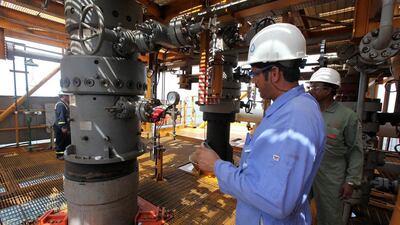Prices of Oman crude on the Dubai Mercantile Exchange last month continued to retreat, with the average monthly price tumbling nearly US$4 per barrel as faltering demand continued to outweigh geopolitical concerns.
DME Oman crude for November delivery settled at $95.89 a barrel on September 30, down 8 cents on the day and a fall of $5.68 a barrel over the month. It was the largest monthly fall since March 2013, when the monthly average dropped by $5.71 a barrel.
Additionally, Oman oil prices have now fallen almost 14 per cent from the June high of $111.18, which coincided with ISIL’s march across northern Iraq.
The monthly average price of the DME, which is used by Oman and Dubai to set their official selling price (OSP) was $97.26, down from $102.23 the previous month and the first sub-$100-a-barrel OSP in more than two years.
Prices last month quickly tumbled below the psychological $100 mark, and the losses were extended following the release of Opec's influential Monthly Oil Market Report, which cut its oil demand forecasts for both this and next year, while at the same time increasing supply forecasts.
The report also noted that Saudi Arabia, the group’s kingpin, had cut its crude production by about 400,000 barrels per day (bpd) during August in response to softer demand and declining prices.
Likewise, the International Energy Agency noted in its last month report that the world’s appetite for crude oil slowed at a “remarkable” pace during the second quarter because of weak economic growth in Europe and China, prompting the West’s energy watchdog to lower its demand forecasts for both this and next year.
In the latter part of the month, Oman found support at the $95 level. The Middle East crudes have generally fared worse than Oman, with grades such as Murban and Upper Zakum from Adnoc, and Qatari grades, all trading at steep discounts to the OSP.
Besides lower-than-expected demand, another factor behind the drop in prices has been a recovery in Libyan output to around 925,000 bpd in September from just 200,000 bpd in June. Additionally, Iraqi production has been little affected by the internal strife and according to the latest Reuters survey, exports from its southern terminals are running at a healthy 2.58 million bpd.
Citibank said that the fall in crude oil prices is part of a wider trend of weaker commodities pricing. In its fourth quarter commodities outlook, it cited weaker global economic conditions, a stronger US dollar, the faltering commodity-intensive Chinese economy, record harvests of US and northern hemisphere row crops, an oversupplied crude oil market and outflows of investor funds in passive indexes and commodity exchange traded funds as major factors which undermined this asset class following a sterling performance in the first and second quarters.
Meanwhile, the sharp fall in prices is raising concerns among some exporters. Iran has called on fellow Opec members to make joint efforts to keep oil prices from falling further.
“Considering the downward trend in prices, Opec members should try to temper production to avoid further price instability”, said Bijan Zanganeh, the Iranian oil minister.
Opec members next meet on November 27, when negotiations will focus on whether the group’s output target of 30 million bpd is appropriate for 2015, given that the group and other forecasters expect a further drop in global demand for Opec crude.
Abdalla El Badri, the Opec secretary general, was quoted by Reuters last week as saying that he expected the group’s production at 29.50 million bpd next year, not 30 million bpd, with the report adding that the UAE, a core Gulf Opec producer, saying it was too early to predict a cut in the Opec target.
Paul Young is the head of energy products at DME
Follow The National's Business section on Twitter

